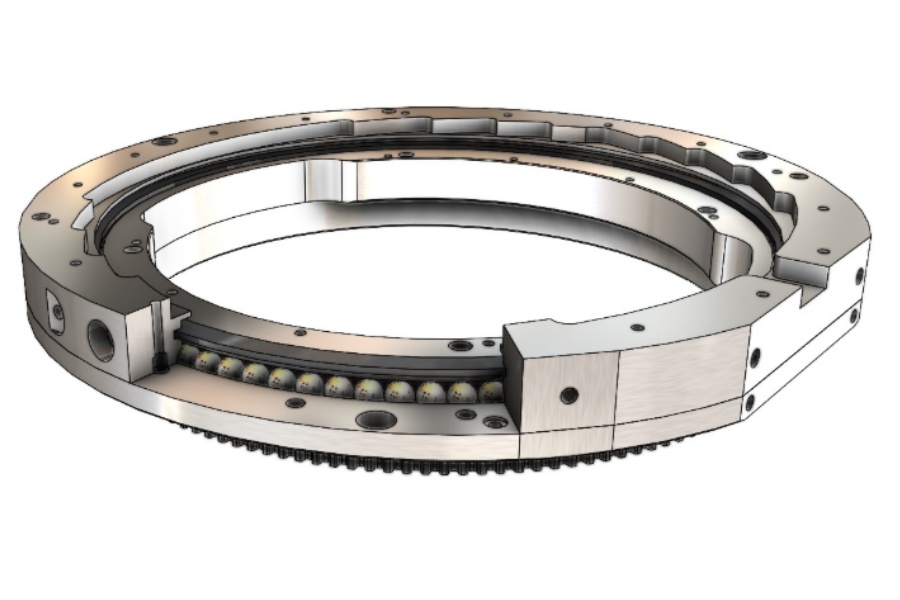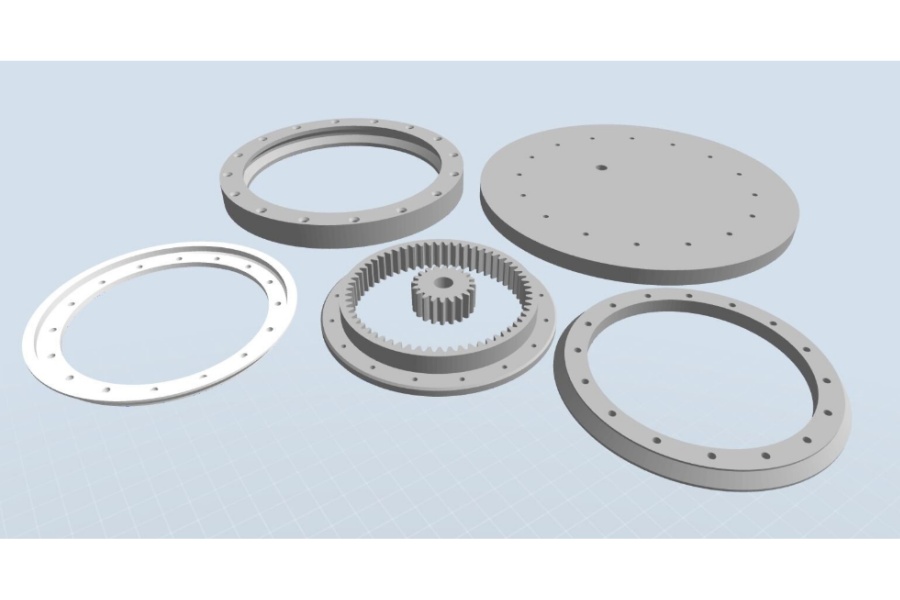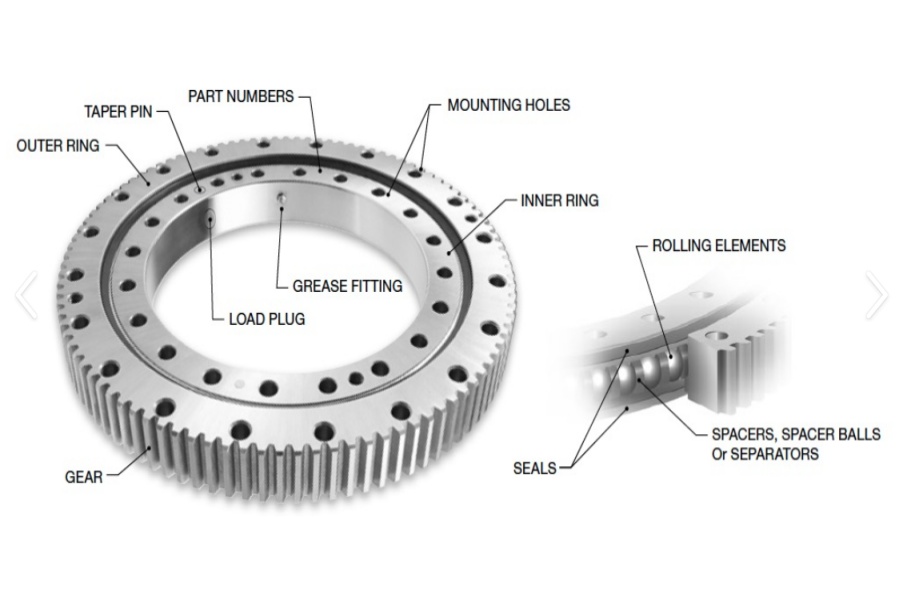
Slewing Bearing: The Core Articulation Point for Industrial Rotation
What is a Slewing Bearing?
A slewing bearing, is a large, specially structured rolling bearing capable of simultaneously withstanding axial loads, radial loads, and overturning moments. Unlike conventional bearings, it typically features a thin-walled ring design, integrating inner and outer rings, rolling elements (balls or rollers), cages, seals, and more. Its core function is to support relatively rotating parts, ensuring smooth, precise, and reliable rotational motion. Essentially, it acts as the "articulation point" connecting fixed and rotating components.

Core Features of Slewing Bearings
The exceptional performance of slewing bearings stems from their unique design characteristics:
Exceptional Load Capacity: Engineered to handle heavy loads and complex combinations of forces (axial, radial, overturning moments), making them ideal for heavy machinery like cranes and excavators.
Compact Structure and High Integration: Thin-wall design saves space, often integrating gears (internal or external), lubrication channels, mounting holes, and sealing systems, simplifying host equipment structure.
High Rotational Precision and Smoothness: Precision manufacturing ensures low friction, low-noise, and stable rotation, meeting the demands of precision equipment such as radar and medical imaging devices.
High Rigidity and Long Service Life: Optimized raceway design and high-quality materials guarantee bearing rigidity, resisting deformation, and providing long-lasting performance even under harsh operating conditions.
Strong Customization Capability: Highly customizable in size, structure (single-row/double-row/triple-row rollers), gear specifications, sealing types, and mounting methods to meet specific host requirements.
Slewing Bearing Applications: The Ubiquitous Core of Rotation
Slewing bearings find extremely wide application, serving as the rotational power source across numerous industries:
Construction Machinery: Rotation platforms for excavators, cranes (tower cranes, mobile cranes, crawler cranes), loaders, rotary drilling rigs, and concrete pump truck booms.
Wind Power Generation: Connecting the tower to the nacelle for yaw (horizontal rotation) and pitch adjustment (blade angle control) movements.
Solar Tracking Systems: Supporting photovoltaic panels to rotate precisely, tracking the sun's trajectory to maximize energy capture.
Port Machinery: Rotation mechanisms for container cranes and stacker-reclaimers.
Military and Aerospace: Precision rotation platforms for radar antenna mounts, missile launchers, and satellite communication equipment.
Medical Equipment: Rotating gantries for CT scanners, linear accelerators, and similar devices.
Industrial Automation: Welding positioners, large rotary tables, and rotating stations in automated assembly lines.
Slewing Bearing CAD: The Cornerstone of Design and Collaboration
In modern bearing design and host equipment integration, Slewing Bearing CAD models are crucial. Manufacturers typically provide precise 3D CAD model files (e.g., STEP, IGES, SOLIDWORKS formats). These models enable host designers to:
Achieve Precise Integration: Seamlessly embed the bearing model into the overall equipment design, ensuring dimensional accuracy, interface compatibility, and spatial fit.
Perform Virtual Assembly and Interference Checks: Identify potential installation conflicts early in the design phase.
Conduct Strength and Motion Simulations: Provide accurate bearing boundary conditions for structural analysis and kinematic simulations of the entire machine.
Accelerate Development: Reduce design iterations and shorten time-to-market.

Slewing Bearing Catalog: The Navigation Map for Selection
A Slewing Bearing Catalog is the core document manufacturers use to showcase their standard product lines and technical capabilities. A comprehensive catalog typically includes:
Product Series Overview: Classification by structure type (single-row ball, double-row ball, cross roller, triple-row roller, etc.) or size range.
Detailed Technical Parameters: Key dimensions (inner diameter, outer diameter, height), dynamic/static load ratings, overturning stiffness, weight, mounting hole information, and gear parameters (if applicable) for each model.
Selection Guide: Instructions on selecting the appropriate model and configuration based on load, operating conditions, speed, and life requirements.
Standard Option Descriptions: Available configurations like seal types, lubrication methods, gear accuracy grades, and material grades.
Application Case References: Examples of successful product applications across different industries.
Dimension Drawing Index: References to detailed drawings for corresponding models.
Slewing Bearing Drawing: The Blueprint for Manufacturing and Acceptance
For a specific selected model, the Slewing Bearing Drawing provides all the precise technical information needed for manufacturing, inspection, and installation:
Exact Geometric Dimensions and Tolerances: All critical dimensions and their allowable manufacturing deviations.
Geometric Tolerances: Key precision requirements like raceway flatness, parallelism, concentricity, and runout.
Material and Heat Treatment Specifications: Material grades for rings, rolling elements, cages, and requirements for heat treatment hardness, depth, etc.
Surface Treatment Requirements: Such as anti-corrosion coatings or raceway surface hardening.
Mounting Interface Details: Bolt hole positions, sizes, accuracy grades, locating spigot requirements.
Gear Parameters (if integrated): Module, number of teeth, pressure angle, accuracy grade, tooth surface treatment.
Marking and Packaging Requirements: Content and location of permanent markings on the bearing, packaging specifications.
Referenced Technical Standards: Compliance with national or international standards (e.g., ISO, JB/T)

Slewing Bearing Dimensions: The Key to Matching
Slewing Bearing Dimensions are the primary factors considered during selection, mainly including:
Nominal Bore Diameter: Diameter of the bearing's inner ring.
Nominal Outside Diameter: Diameter of the bearing's outer ring.
Assembly Height/Thickness: The total height (axial dimension) of the bearing.
Bolt Hole Information: Number of mounting holes, pitch circle diameter, hole diameter, hole type (through hole/tapped hole).
Gear Parameters (if integrated): Gear module, number of teeth, tip diameter, root diameter.
Raceway Center Diameter: Influences the bearing's moment load capacity.
These dimensions must precisely match the host equipment's mounting space, interface design, and the characteristics of the transmitted loads and moments. Calculating dynamic loads and overturning moments is fundamental to determining the correct size specification.
Key Factors Influencing Slewing Bearing Price
The price of slewing bearings varies significantly, primarily driven by the following factors:
Size and Load Capacity: Larger sizes and higher load ratings (especially overturning moments) require more material, increase manufacturing difficulty and cost, resulting in higher prices.
Structural Complexity: Single-row ball bearings are relatively simple and economical; double-row ball, triple-row roller, and cross roller structures are more complex, offer higher load capacity, and are more costly; integrating gears (especially high-precision gears) significantly increases cost and price.
Material Grade and Heat Treatment: Using high-strength, high-purity alloy steels (e.g., 42CrMo, 50Mn), deeper surface hardening layers, and stricter heat treatment processes greatly enhance performance and lifespan but also drive up costs. Material cost typically accounts for over 40% of the total cost.
Manufacturing Precision Grade: Higher requirements for dimensional accuracy, geometric tolerances (e.g., raceway runout), gear accuracy (AGMA/ISO grade), and surface finish necessitate more precise machining equipment and stricter inspection, increasing costs accordingly.
Sealing and Lubrication Systems: High-performance multi-lip seals, labyrinth seals, special seal materials, and centralized automatic lubrication interfaces add complexity and cost.
Special Requirements: Such as special anti-corrosion treatments for extreme environments (galvanizing, Dacromet, spraying), special clearances, special cage materials (e.g., engineering plastics, copper alloys), or non-standard designs, all incur additional costs.
Brand and Market Supply/Demand: Well-known brands usually command a premium; market supply and demand also cause price fluctuations.
Supplier of Slewing Bearing
LYRA Drive is a professional slewing bearings ,slew drive and gears manufacturer provides customized slew bearing, drive and gears.For application-specific engineering solutions, contact LYRA to discuss technical specifications and implementation strategies.



